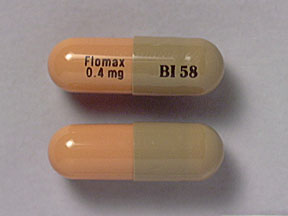Flomax Disease Interactions
There are 4 disease interactions with Flomax (tamsulosin).
Tamsulosin (applies to Flomax) glaucoma
Major Potential Hazard, Moderate plausibility. Applicable conditions: Glaucoma/Intraocular Hypertension, Cataracts
Intraoperative Floppy Iris Syndrome (IFIS) has been observed during cataract and glaucoma surgery in some patients on or previously treated with alpha 1 blockers, including tamsulosin. The initiation of therapy with tamsulosin in patients for whom cataract or glaucoma surgery is scheduled is not recommended. The patient's ophthalmologist should be aware if the patient is receiving treatment with this drug and should be prepared for possible modifications to the surgical technique, such as the utilization of iris hooks, iris dilator rings, or viscoelastic substances.
Alpha-1 blockers (applies to Flomax) hypotension
Moderate Potential Hazard, Moderate plausibility. Applicable conditions: Autonomic Neuropathy, Syncope, Dehydration, Diarrhea, Vomiting
Peripheral alpha 1- adrenergic receptor blocking agents (aka alpha 1- blockers) cause vasodilation and can produce marked hypotension, especially orthostatic hypotension with syncope or other postural symptoms such as dizziness, lightheadedness, and palpitations. Orthostatic effects are most common during initiation of therapy and often occur within 90 minutes after the first dose. However, they can also occur following a dosage increase or resumption of therapy after an interruption of more than a few days. Agents with alpha 1a specificity, such as tamsulosin, act primarily on the prostate but are not devoid of hypotensive effects. Therapy with peripheral alpha-1 blockers should be administered cautiously in patients with or predisposed to hypotensive or syncopal episodes. Caution is also advised in patients who are dehydrated (e.g., due to severe or prolonged diarrhea or vomiting), since they may be more sensitive to the hypotensive effect of the drugs. Therapy should be initiated with the lowest dosage possible and titrated gradually based on patient response and tolerance in accordance with the individual product package labeling. During initiation or reinstitution of therapy and following an increase in dosage, patients should be advised not to rise abruptly from a sitting or recumbent position and to avoid situations where injury could result if syncope occur. Concomitant use of alcohol, extensive periods of standing, prolonged or intense exercise, and exposure to heat can also precipitate orthostatic hypotension and should be minimized. If dizziness, lightheadedness or palpitations occur, the patient should sit or lie down, and seek medical attention if symptoms are recurrent or bothersome.
Tamsulosin (applies to Flomax) end-stage renal disease
Moderate Potential Hazard, Moderate plausibility. Applicable conditions: Renal Dysfunction
Patients with renal impairment do not require an adjustment in tamsulosin dosing. However, patients with end-stage renal disease (Clcr <10 mL/min) have not been studied.
Tamsulosin (applies to Flomax) severe liver disease
Moderate Potential Hazard, Moderate plausibility.
Patients with moderate hepatic impairment do not require any adjustment in tamsulosin dosage. Tamsulosin has not been studied in patients with severe hepatic impairment.
Switch to professional interaction data
Flomax drug interactions
There are 311 drug interactions with Flomax (tamsulosin).
Flomax alcohol/food interactions
There are 2 alcohol/food interactions with Flomax (tamsulosin).
More about Flomax (tamsulosin)
- Flomax consumer information
- Check interactions
- Compare alternatives
- Pricing & coupons
- Reviews (299)
- Drug images
- Side effects
- Dosage information
- Patient tips
- During pregnancy
- Support group
- Drug class: alpha blockers
- Breastfeeding
- En español
Related treatment guides
Drug Interaction Classification
| Highly clinically significant. Avoid combinations; the risk of the interaction outweighs the benefit. | |
| Moderately clinically significant. Usually avoid combinations; use it only under special circumstances. | |
| Minimally clinically significant. Minimize risk; assess risk and consider an alternative drug, take steps to circumvent the interaction risk and/or institute a monitoring plan. | |
| No interaction information available. |
See also:
Further information
Always consult your healthcare provider to ensure the information displayed on this page applies to your personal circumstances.


